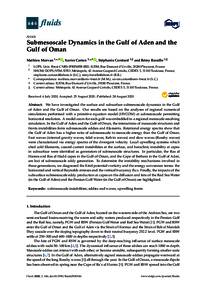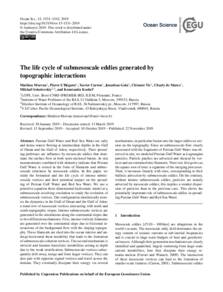Document
Submesoscale dynamics in the Gulf of Aden and the Gulf of Oman.
Identifier
DOI: 10.3390/fluids5030146
Source
Fluids. v. 5, 3, 146
Contributors
Country
Switzerland
Publisher
MDPI AG.
Gregorian
2020-09-01
Language
English
Subject
English abstract
We have investigated the surface and subsurface submesoscale dynamics in the Gulf of Aden and the Gulf of Oman. Our results are based on the analyses of regional numerical simulations performed with a primitive equation model (HYCOM) at submesoscale permitting horizontal resolution. A model zoom for each gulf was embedded in a regional mesoscale-resolving simulation. In the Gulf of Aden and the Gulf of Oman, the interactions of mesoscale structures and fronts instabilities form submesoscale eddies and filaments. Rotational energy spectra show that the Gulf of Aden has a higher ratio of submesoscale to mesocale energy than the Gulf of Oman. Fast waves (internal gravity waves, tidal waves, Kelvin waves) and slow waves (Rossby waves) were characterized via energy spectra of the divergent velocity. Local upwelling systems which shed cold filaments, coastal current instabilities at the surface, and baroclinic instability at capes in subsurface were identified as generators of submesocale structures. In particular, the Ras al Hamra and Ras al Hadd capes in the Gulf of Oman, and the Cape of Berbera in the Gulf of Aden, are loci of submesoscale eddy generation. To determine the instability mechanisms involved in these generations, we diagnosed the Ertel potential vorticity and the energy conversion terms: the horizontal and vertical Reynolds stresses and the vertical buoyancy flux. Finally, the impacts of the subsurface submesoscale eddy production at capes on the diffusion and fate of the Red Sea Water (in the Gulf of Aden) and the Persian Gulf Water (in the Gulf of Oman) are highlighted.
ISSN
2311-5521
Resource URL
Category
Journal articles


